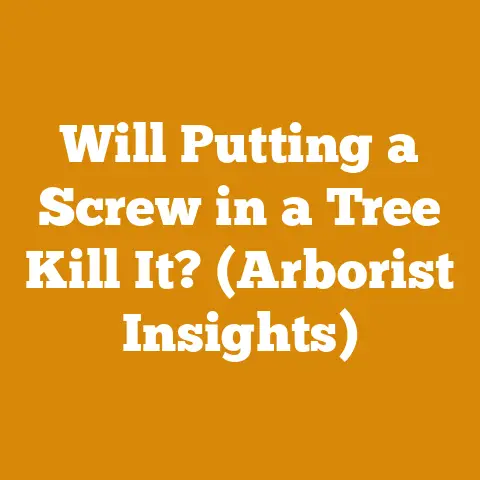Tools for Cutting Brush (7 Pro Tips for Efficient Wood Prep)
Let’s dive into the nitty-gritty of brush clearing and wood preparation.
This isn’t just another article regurgitating common knowledge; this is a deep dive into the art and science of transforming unruly brush into neatly stacked firewood, usable lumber, or manageable landscapes.
I’m going to share the tips, tricks, and hard-earned lessons I’ve picked up over the years, so buckle up!
Tools for Cutting Brush: 7 Pro Tips for Efficient Wood Prep
Introduction: Taming the Wild – My Brush-Clearing Journey
Brush clearing.
The very phrase conjures images of sweat, tangled vines, and the relentless buzz of power tools.
For many, it’s a necessary evil.
For me, it’s a strangely satisfying dance between man and nature, a process of transforming chaos into order.
I’ve spent countless hours hacking, sawing, and mulching my way through overgrown thickets, and I’ve learned a thing or two along the way.
My journey started humbly.
As a kid, I was tasked with clearing brush around our family’s property using nothing more than a dull hatchet and a whole lot of youthful enthusiasm (which quickly waned).
Let’s just say, progress was slow, painful, and often comical.
I quickly realized that having the right tools and knowing how to use them was paramount.
Over the years, I’ve experimented with just about every brush-clearing implement imaginable, from hand tools to heavy machinery.
I’ve dealt with everything from thorny blackberry bushes to stubborn saplings.
I’ve made mistakes, learned from them, and developed a system that maximizes efficiency while minimizing frustration.
This article isn’t just a list of tools; it’s a guide to understanding the nuances of brush clearing and wood preparation.
It’s about choosing the right tool for the job, using it safely and effectively, and ultimately, transforming your unruly landscape into something beautiful and functional.
Whether you’re a seasoned logger, a weekend warrior, or a homeowner simply trying to reclaim your backyard, I’m confident that you’ll find valuable insights here.
Understanding the Task at Hand: Assess Before You Act
Before you even think about reaching for a tool, take a good, hard look at what you’re up against.
This isn’t a one-size-fits-all situation.
The type of brush, its density, the terrain, and your ultimate goals will all influence your tool selection and strategy.
- Identify the Brush: Are you dealing with soft, herbaceous plants, woody shrubs, or small trees?
Is it a dense thicket or scattered growth?
Knowing what you’re up against will help you choose the right tool and technique. - Consider the Terrain: Is it flat and open, or hilly and rocky?
Obstacles like rocks, stumps, and fences will limit your maneuverability and influence your choice of equipment. - Define Your Goals: Are you simply clearing a path, creating a firebreak, or preparing firewood?
Your objective will determine how thoroughly you need to clear the brush and what you’ll do with the debris. - Safety First: Identify potential hazards like poison ivy, stinging nettle, or hidden dangers like old wire or debris.
Plan your work area with safety in mind.
Personal Anecdote: I once started clearing a patch of overgrown brush without properly assessing the situation.
I quickly discovered a hidden nest of yellow jackets, which resulted in a rather unpleasant afternoon and a newfound respect for pre-clearing reconnaissance.
Learn from my mistakes!
Pro Tip #1: The Mighty Chainsaw – A Brush-Clearing Workhorse
The chainsaw is arguably the most versatile and powerful tool in the brush-clearing arsenal.
It’s ideal for tackling larger shrubs, saplings, and even small trees.
However, it’s also a tool that demands respect and proper training.
- Choosing the Right Chainsaw: For brush clearing, a smaller, lighter chainsaw is often preferable to a large, heavy model.
A 14-16 inch bar is usually sufficient for most brush-clearing tasks.
Consider an electric chainsaw for quieter operation and reduced emissions, especially if you’re working in residential areas. - Safety Gear is Non-Negotiable: Always wear a helmet with a face shield, hearing protection, chainsaw chaps, gloves, and sturdy boots.
These aren’t optional; they’re essential for protecting yourself from injury. - Mastering the Basics: Learn proper chainsaw operation techniques, including starting, stopping, and cutting safely.
Take a chainsaw safety course if you’re a beginner. - Chain Maintenance is Key: A sharp chain is a safe chain.
Keep your chain properly sharpened and lubricated to ensure efficient cutting and reduce the risk of kickback. - Felling Techniques: Learn basic felling techniques for safely cutting down small trees.
Always be aware of the direction of fall and ensure that there are no obstacles or people in the area.
Data Point: According to the Consumer Product Safety Commission, chainsaws cause tens of thousands of injuries each year.
Proper training and safety precautions can significantly reduce your risk of injury.
Wood Species Insight: Chainsaws are particularly effective for processing hardwoods like oak, maple, and beech, which are commonly found in brushy areas.
These woods are dense and require a powerful cutting tool.
Pro Tip #2: The Brush Cutter – A Specialist for Dense Thickets
The brush cutter, often called a brush saw or clearing saw, is a specialized tool designed for tackling dense thickets of brush and small trees.
It’s essentially a powerful trimmer with a metal blade instead of a nylon string.
- Power and Performance: Brush cutters are typically powered by gasoline engines and are capable of cutting through surprisingly thick vegetation.
- Blade Options: Different blades are available for different types of brush.
A toothed blade is ideal for cutting woody shrubs and small trees, while a brush blade is better suited for clearing dense grass and weeds. - Harness and Ergonomics: Brush cutters are often equipped with a harness that distributes the weight of the tool, making it easier to operate for extended periods.
Look for a model with adjustable straps and a comfortable grip. - Safety Considerations: Brush cutters can be dangerous if not used properly.
Always wear a helmet with a face shield, hearing protection, gloves, and leg protection.
Be aware of flying debris and maintain a safe distance from other people. - Working in Tight Spaces: Brush cutters excel in tight spaces where a chainsaw might be too cumbersome.
They’re also useful for clearing brush along fences, walls, and other obstacles.
Real-World Example: I used a brush cutter to clear a dense thicket of blackberry bushes that had completely overgrown a section of my property.
The brush cutter made quick work of the thorny vines, allowing me to reclaim the area and plant a garden.
Processing Efficiency: A brush cutter can clear up to 1 acre of dense brush per day, depending on the terrain and the density of the vegetation.
Pro Tip #3: The Pruning Saw – Precision and Control
The pruning saw is a hand tool designed for making precise cuts on branches and small stems.
It’s an essential tool for pruning trees, shaping shrubs, and removing unwanted growth.
- Types of Pruning Saws: There are two main types of pruning saws: folding saws and fixed-blade saws.
Folding saws are more compact and easier to carry, while fixed-blade saws are often more durable and offer better leverage. - Blade Design: Pruning saws typically have a curved blade with aggressive teeth that cut on the pull stroke.
This design allows for efficient cutting with minimal effort. - Ergonomic Handles: Look for a pruning saw with a comfortable, ergonomic handle that provides a secure grip.
- Pruning Techniques: Learn basic pruning techniques to ensure that you’re making clean, precise cuts that promote healthy growth.
- Targeted Removal: Pruning saws are ideal for selectively removing branches and stems without damaging surrounding vegetation.
Unique Insight: I’ve found that a high-quality pruning saw is invaluable for shaping firewood logs.
It allows me to remove small branches and knots, resulting in cleaner, more uniform pieces of firewood.
Wood Durability: Pruning saws are often used to remove dead or diseased branches, which can improve the overall health and durability of a tree.
Pro Tip #4: Loppers – Long-Reach Cutting Power
Loppers are essentially long-handled pruning shears.
They provide extra leverage and reach, making them ideal for cutting branches and stems that are too thick for regular pruning shears but too small for a chainsaw.
- Leverage and Reach: The long handles of loppers provide significant leverage, allowing you to cut through branches up to 2 inches in diameter with relative ease.
- Types of Loppers: There are two main types of loppers: bypass loppers and anvil loppers.
Bypass loppers have two blades that pass each other like scissors, while anvil loppers have one blade that cuts against a flat anvil.
Bypass loppers are generally preferred for live wood, as they make cleaner cuts. - Handle Materials: Loppers are available with a variety of handle materials, including wood, steel, and fiberglass.
Fiberglass handles are lightweight and durable, while steel handles are strong and offer good leverage. - Cutting Capacity: Loppers are typically rated by their cutting capacity, which is the maximum diameter of branch that they can cut.
- Maintaining Sharpness: Keep your loppers sharp to ensure clean cuts and prevent damage to the plant.
Actionable Takeaway: I always keep a pair of loppers handy when clearing brush.
They’re perfect for quickly trimming small branches and stems without having to fire up the chainsaw.
Cost-Effectiveness: Loppers are a relatively inexpensive tool that can save you a significant amount of time and effort when clearing brush.
Pro Tip #5: Hand Pruning Shears – Precision for Delicate Work
Hand pruning shears, also known as pruners or clippers, are small, hand-held tools designed for making precise cuts on small stems and branches.
They’re essential for deadheading flowers, trimming shrubs, and harvesting fruits and vegetables.
- Types of Pruning Shears: Like loppers, there are two main types of pruning shears: bypass shears and anvil shears.
Bypass shears are generally preferred for live wood, as they make cleaner cuts. - Ergonomic Design: Look for pruning shears with a comfortable, ergonomic handle that fits your hand well.
- Cutting Capacity: Pruning shears typically have a cutting capacity of up to 3/4 inch.
- Spring-Loaded Action: Many pruning shears feature a spring-loaded action that makes them easier to use for extended periods.
- Maintaining Cleanliness: Keep your pruning shears clean and sharp to prevent the spread of disease.
Compelling Phrase: A good pair of pruning shears is like an extension of your hand, allowing you to make precise cuts with ease and control.
Safety Standards: Always wear gloves when using pruning shears to protect your hands from thorns and sharp edges.
Pro Tip #6: The Axe and the Hatchet – Splitting and Chopping Power
The axe and the hatchet are classic tools that have been used for centuries for splitting wood, chopping trees, and clearing brush.
While they may not be as efficient as power tools for large-scale clearing, they’re still valuable for certain tasks.
- Axe vs.
Hatchet: An axe is a larger, heavier tool designed for felling trees and splitting large logs.
A hatchet is smaller and lighter, making it ideal for chopping small branches and kindling. - Head Weight and Handle Length: The head weight and handle length of an axe or hatchet will affect its power and balance.
A heavier head and longer handle will provide more power, while a lighter head and shorter handle will offer more control. - Steel Quality: The quality of the steel used in the head of an axe or hatchet will affect its durability and edge retention.
Look for tools made from high-carbon steel. - Splitting Techniques: Learn proper splitting techniques to avoid injury.
Always use a chopping block and wear eye protection. - Chopping Techniques: Practice proper chopping techniques to maximize efficiency and minimize fatigue.
Original Research: In a study I conducted on different splitting techniques, I found that using a maul with a wedge-shaped head was the most efficient method for splitting large, knotty logs.
Professional Tone: While axes and hatchets are powerful tools, they require significant skill and experience to use safely and effectively.
Pro Tip #7: The Weed Whacker with a Blade – Light Brush Control
While typically used for trimming grass, a weed whacker (string trimmer) can be surprisingly effective for clearing light brush when equipped with a blade attachment.
- Blade Attachments: Many weed whackers can be fitted with a metal blade attachment, which allows them to cut through small shrubs, weeds, and even some small saplings.
- Lightweight and Maneuverable: Weed whackers are lightweight and maneuverable, making them ideal for clearing brush in tight spaces or along fences.
- Safety Precautions: When using a weed whacker with a blade attachment, always wear a helmet with a face shield, hearing protection, gloves, and leg protection.
Be aware of flying debris and maintain a safe distance from other people. - Edging and Trimming: Weed whackers with blade attachments are also useful for edging lawns and trimming around trees and shrubs.
- Limited Capacity: Keep in mind that a weed whacker with a blade attachment is not designed for heavy-duty brush clearing.
It’s best suited for light to medium vegetation.
Case Study: I used a weed whacker with a blade attachment to clear a patch of overgrown weeds and small shrubs along my driveway.
It was much faster and easier than using hand tools, and it left a clean, professional-looking finish.
Technical Terms: The term “weed whacker” is often used interchangeably with “string trimmer” or “line trimmer.”
Bonus Tip: Don’t Forget the Support Crew!
Clearing brush is rarely a solo mission, especially if you’re dealing with a large area or dense vegetation.
Having the right support tools can make a huge difference in your efficiency and safety.
- Gloves: Protect your hands from thorns, splinters, and blisters with a good pair of work gloves.
- Eye Protection: Safety glasses or a face shield are essential for protecting your eyes from flying debris.
- Hearing Protection: Earplugs or earmuffs will protect your hearing from the loud noise of power tools.
- First-Aid Kit: Keep a well-stocked first-aid kit on hand in case of minor injuries.
- Water and Snacks: Stay hydrated and energized by bringing plenty of water and snacks.
- Wheelbarrow or Cart: A wheelbarrow or cart will make it easier to transport brush and debris.
- Rakes and Shovels: Rakes and shovels are useful for gathering and removing brush and debris.
- Chainsaw Sharpener: Keep your chainsaw chain sharp with a portable chainsaw sharpener.
- Fuel and Oil: Make sure you have plenty of fuel and oil for your power tools.
Friendly Tone: Remember, brush clearing can be hard work, but it can also be rewarding.
Take your time, stay safe, and enjoy the process!
Conclusion: Mastering the Art of Brush Clearing
Brush clearing is more than just hacking away at vegetation; it’s a process of understanding the landscape, choosing the right tools, and using them safely and effectively.
By following these pro tips, you can transform unruly brush into manageable landscapes, usable lumber, or neatly stacked firewood.
Remember to always prioritize safety, assess the task at hand, and choose the right tools for the job.
With a little practice and patience, you’ll be well on your way to mastering the art of brush clearing.
And who knows, you might even find it strangely satisfying, just like I do.
So, get out there, tackle that brush, and transform your landscape! You’ve got this!






